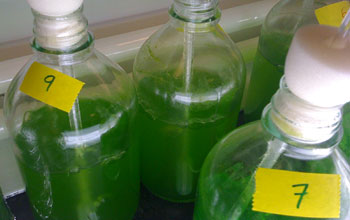News Release 09-178
Building on Nature
Biology inspires the pursuit of new capabilities in sensing and hydrocarbon production

Growing microalgae with high oil content is one obstacle that a Michigan team will try to overcome.
September 28, 2009
This material is available primarily for archival purposes. Telephone numbers or other contact information may be out of date; please see current contact information at media contacts.
Natural systems are the focus of two intriguing and imperative research areas: creating revolutionary capabilities for sensing and response; and obtaining hydrocarbons from plants and microorganisms.
The National Science Foundation (NSF) has announced 20 grants in these areas for FY 2009, awarding a total of $39,991,202 over four years to 94 investigators from 27 institutions through the NSF Office of Emerging Frontiers in Research and Innovation (EFRI).
"Big ideas are needed if we are to significantly advance the development of biosensing and biofuels," said Thomas Peterson, NSF assistant director for engineering. "That's why EFRI is stimulating high-risk research in these areas of national need."
In the first area, researchers will study how fish move, how butterflies drink, how spiders see, and even how the Venus flytrap catches dinner, and then find ways to engineer these mechanisms for sensing and response into new materials and systems.
Other researcher teams will investigate the behavior of DNA, neurons and other biological tissues to discover how to harness their activity to produce materials or improve their function, or how to detect the beginnings of diseases such as cancer or immune disorders.
Sohi Rastegar, director of EFRI, said, "Working at the interface of living and engineered systems presents many challenges but also new opportunities for discoveries that will address a number of national needs, which include detecting precursors of serious diseases, protecting critical and aging infrastructures, and mitigating environmental hazards and pollution."
A second group of researchers will investigate the production of hydrocarbons from biomass as an alternative to petroleum. Non-food sources of biomass with great energy potential include crops such as algae, switchgrass and poplar trees, and residues from lumber and agriculture.
"If an effective conversion pathway is found, biomass could provide a sustainable and significant source of gasoline and diesel fuels, as well as essential chemicals," said Rastegar. "Furthermore, these green fuels and chemicals would be compatible with existing infrastructure."
The researchers will produce hydrocarbons by pioneering processes for chemically converting plant material and by natural microbial and fungal processes that are even less-explored. They will also investigate methods for making hydrocarbon production fast, continuous, scalable, and cost-effective.
To maximize the efficiency of biomass conversion, some research teams will be breaking down even the tough plant material called lignin (typically an unused residue). Some researchers will turn waste heat into electricity. And some will tweak their processes--whether chemical or natural--to produce precisely the hydrocarbons we need.
"While results from EFRI investigations are uncertain," continued Rastegar, "we are determined to pursue them, because their pay-off could be enormous."
These EFRI projects all include a component for educating the future workforce in these areas, whether by engaging undergraduate- and graduate-level researchers, by developing interdisciplinary curricula, or by inspiring future generations through camps and outreach activities.
The NSF Directorate for Engineering created EFRI in 2007 to fund high-risk, interdisciplinary research that has the potential to transform engineering and other fields. The grants demonstrate the EFRI goal to inspire and enable researchers to expand the limits of our knowledge while advancing national priorities.
Summaries of the 12 Biosensing and Bioactuation (BSBA) Projects
Summaries of the 8 Hydrocarbons from Biomass (HyBi) Projects
-NSF-
-
A photobioreactor provides a stable, controllable environment for growing marine microalgae.
Credit and Larger Version -
Researchers will investigate photosynthetic mechanisms that naturally produce simple hydrocarbons.
Credit and Larger Version -
Montana State grad student Natasha Mallette works with a fermentation system for converting biomass.
Credit and Larger Version -
The schematic depicts an array of micro-cameras that incorporates many features of natural eyes.
Credit and Larger Version -
Plants with valuable abilities, such as Venus flytraps, inspire designs for microstructure systems.
Credit and Larger Version -
Washington researchers envision a contact lens system capable of measuring biomedical information.
Credit and Larger Version -
A Virginia Tech team will create materials to mimic fish's unusual movement and sensing abilities.
Credit and Larger Version -
Getting hydrocarbons from energy-rich woody plants containing lignin will be studied in Kentucky.
Credit and Larger Version
Media Contacts
Cecile J. Gonzalez, NSF, (703) 292-8538, email: cjgonzal@nsf.gov
Joshua A. Chamot, NSF, (703) 292-7730, email: jchamot@nsf.gov
Program Contacts
Sohi Rastegar, NSF, (703) 292-8305, email: srastega@nsf.gov
Related Websites
Office of Emerging Technologies in Research and Innovation (EFRI): http://www.nsf.gov/div/index.jsp?org=EFRI
BioSensing and BioAcutation (BSBA) program contacts: http://www.nsf.gov/staff/staff_list.jsp?orgId=5157&subDiv=y&org=EFRI&from_org=EFRI
Hydrocarbons from Biomass (HyBi) program contacts: http://www.nsf.gov/staff/staff_list.jsp?orgId=5158&subDiv=y&org=EFRI&from_org=EFRI
The U.S. National Science Foundation propels the nation forward by advancing fundamental research in all fields of science and engineering. NSF supports research and people by providing facilities, instruments and funding to support their ingenuity and sustain the U.S. as a global leader in research and innovation. With a fiscal year 2023 budget of $9.5 billion, NSF funds reach all 50 states through grants to nearly 2,000 colleges, universities and institutions. Each year, NSF receives more than 40,000 competitive proposals and makes about 11,000 new awards. Those awards include support for cooperative research with industry, Arctic and Antarctic research and operations, and U.S. participation in international scientific efforts.
Connect with us online
NSF website: nsf.gov
NSF News: nsf.gov/news
For News Media: nsf.gov/news/newsroom
Statistics: nsf.gov/statistics/
Awards database: nsf.gov/awardsearch/
Follow us on social
Twitter: twitter.com/NSF
Facebook: facebook.com/US.NSF
Instagram: instagram.com/nsfgov










